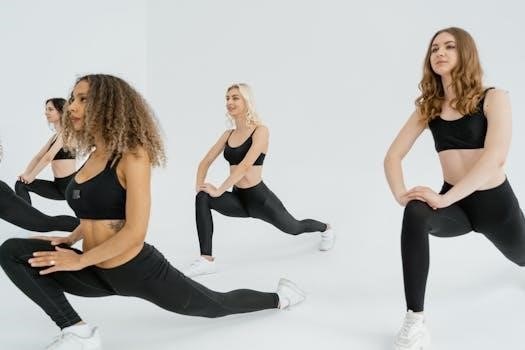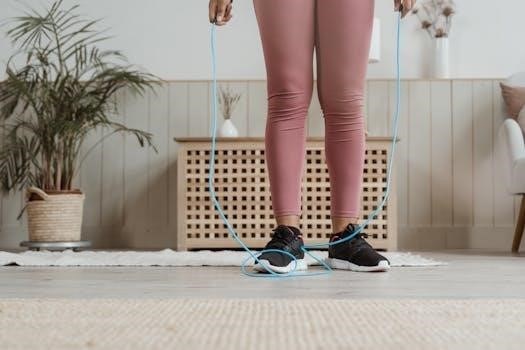Body Pump Workout Routine PDF⁚ A Comprehensive Guide
Body Pump is a popular group fitness class that uses barbells and weights to build strength and endurance. A Body Pump workout routine PDF can provide structured guidance for effective training, ensuring proper form and progression.
What is Body Pump?
Body Pump is a total body workout program using light to moderate weights with lots of repetition. This format challenges all your major muscle groups by using exercises like Squats, Presses, Lifts, and Curls, often in a class setting. The goal is to strengthen and tone your body, pushing you to the limit every time with great music and awesome instructors.
Body Pump classes typically run for 60 minutes. These classes are designed to burn calories, shape, and tone your entire body, increase core strength, and improve bone health. It is essential to allow for recovery time between workouts to prevent overtraining and injuries.

Benefits of Body Pump Workouts
Body Pump workouts offer numerous benefits, including full-body strengthening, increased muscular endurance, and significant calorie burning. Regular participation can lead to improved overall fitness and a toned physique.
Full Body Workout
Body Pump stands out as a comprehensive full-body workout, engaging all major muscle groups in a single session. This is achieved through a structured class format that incorporates exercises targeting the legs, chest, back, shoulders, biceps, triceps, and core. Each muscle group receives focused attention, ensuring balanced development and overall strength gains. The use of light to moderate weights with high repetitions promotes muscular endurance and definition.
This full-body approach makes Body Pump an efficient and effective way to achieve a well-rounded fitness level, suitable for individuals seeking to improve their strength, tone their muscles, and enhance their overall physical conditioning. Regular participation can lead to noticeable improvements in strength, stamina, and body composition.
Strength and Endurance
Body Pump is designed to enhance both strength and endurance by utilizing a high-repetition, low-weight training approach. This method effectively challenges muscles to work for extended periods, building muscular endurance rather than maximal strength. The class structure incorporates compound exercises like squats, presses, and deadlifts, which engage multiple muscle groups simultaneously, further contributing to overall strength development.
The continuous movement and repetitive nature of Body Pump also elevate the heart rate, improving cardiovascular endurance. Over time, participants experience increased stamina and the ability to perform physical activities for longer durations without fatigue. This combination of strength and endurance makes Body Pump a valuable workout for individuals seeking to improve their overall fitness level.
Calorie Burning
Body Pump is an effective workout for burning calories due to its full-body nature and high-repetition structure. The continuous movement and engagement of multiple muscle groups elevate the heart rate and increase energy expenditure, leading to a significant calorie burn during and after the workout. The use of weights further intensifies the calorie-burning effect as the body works harder to lift and control the resistance.
The post-exercise calorie burn, also known as the “afterburn effect,” is another benefit of Body Pump. As the body recovers from the intense workout, it continues to burn calories at an elevated rate, contributing to overall weight management and improved body composition. The combination of cardiovascular and resistance training makes Body Pump a great choice for those looking to burn calories and achieve their fitness goals.

Body Pump Workout Structure
A typical Body Pump class follows a structured format, beginning with a warm-up, moving into the main workout targeting different muscle groups, and concluding with a cool-down and stretching session for flexibility.
Warm-up
The warm-up in a Body Pump class is designed to prepare your muscles for the workout ahead. It typically involves light cardio and dynamic stretches to increase blood flow and flexibility. The purpose of warming up all major muscle groups will prepare the body for the workout ahead. This phase usually includes lighter weights or no weights at all; Focus on controlled movements to activate the muscles you’ll be using during the main workout. A good warm-up helps prevent injuries and improves performance. This is where instructors will also go over some instructions before the main workout commences. Ensure your technique and posture are correct before adding any weight.
Main Workout (Squats, Chest, Back, etc.)
The main workout in Body Pump targets all major muscle groups through a series of exercises. These typically include squats, chest presses, deadlifts, rows, and lunges. Each exercise focuses on high repetitions with moderate weight to build muscular endurance. Proper form is crucial to avoid injury and maximize results. Instructors guide participants through each movement, providing cues and modifications as needed. The goal is to fatigue the muscles, leading to increased strength and tone. The main workout is structured to provide a full-body challenge in approximately 60 minutes, pushing you to the limit.
Cool-down
The cool-down phase in a Body Pump class is essential for recovery and preventing muscle soreness. It typically involves static stretching, holding each stretch for 30 seconds to improve flexibility. The cool-down targets major muscle groups worked during the session, such as the quadriceps, hamstrings, chest, and back. Stretching helps to reduce muscle tension and improve blood flow, aiding in the removal of metabolic waste products. A proper cool-down also helps to lower the heart rate and bring the body back to a resting state. It is an important part of the workout to promote overall well-being and prepare the body for the next workout.
Sample Body Pump Routine (PDF Options)
Looking for a Body Pump routine? Several PDF options are available online, offering structured workout plans. These resources provide schedules and exercises to guide you through effective training sessions.
90-Day Workout Calendar
A 90-day workout calendar provides a structured plan to follow for an extended period, helping to establish consistency and track progress. For Body Pump enthusiasts, such a calendar can be invaluable. A PDF version allows for easy access and portability, enabling users to follow the routine at home or in the gym. These calendars often include a progression of exercises, gradually increasing intensity and resistance.
They help to ensure that all muscle groups are worked effectively throughout the 90 days. A well-designed calendar can significantly improve fitness results. It also promotes adherence to the workout routine.
Weekly Workout Schedule Examples
Weekly workout schedule examples offer structured approaches to incorporating Body Pump into your fitness regimen. These schedules provide a clear plan for each week, specifying which muscle groups to target and when. A typical schedule might include two to three Body Pump sessions per week, complemented by cardio or rest days;
Different examples can cater to varying fitness levels and goals, such as muscle gain, endurance, or weight loss. A well-designed schedule helps to ensure balanced muscle development and prevents overtraining. It provides a framework to maintain consistency and achieve optimal results from your Body Pump workouts.

Essential Exercises in a Body Pump Routine
Essential exercises in Body Pump include squats, chest presses, deadlifts, and rows. These movements target major muscle groups, promoting full-body strength and endurance. Proper form is crucial for maximizing benefits and preventing injuries during these exercises.
Squats
Squats are a cornerstone of any Body Pump routine, engaging the quadriceps, hamstrings, and glutes. In Body Pump, squats are performed with a barbell across the upper back, allowing for controlled movements and increased resistance. Maintaining proper form is essential to prevent injuries and maximize muscle activation. Focus on keeping your back straight, chest up, and knees behind your toes as you lower into the squat. The tempo and range of motion can be varied to challenge different aspects of muscle strength and endurance. Incorporating squats into your routine will provide excellent fitness results.
Chest Press
The chest press is a fundamental exercise in Body Pump, targeting the pectoral muscles, anterior deltoids, and triceps. Typically performed on a bench with a barbell, the chest press involves lowering the weight to the chest and pressing it back up, focusing on controlled movements. Maintaining proper form is crucial to prevent shoulder injuries and ensure effective muscle engagement. Varying the weight and tempo can challenge the muscles in different ways, promoting strength and endurance. A well-executed chest press contributes to overall upper body strength and muscle tone, making it a key component of a Body Pump routine.
Deadlifts
Deadlifts are a powerful compound exercise included in Body Pump, engaging multiple muscle groups, including the back, hamstrings, glutes, and core. In a Body Pump setting, lighter weights are used with higher repetitions to build muscular endurance and improve overall strength. The exercise involves lifting a barbell from the floor to a standing position, maintaining a straight back and engaging the core throughout the movement. Proper form is essential to prevent back injuries, focusing on hinging at the hips and keeping the spine neutral. Deadlifts enhance functional strength and contribute to improved posture and core stability, making them a valuable part of a Body Pump workout routine.

Tips for Effective Body Pump Workouts
To maximize results in Body Pump, focus on proper form, gradual weight increases, and listen to your body. Prioritize rest and recovery to prevent injuries and ensure continuous progress.
Proper Form and Technique
Maintaining proper form and technique in Body Pump is crucial to prevent injuries and maximize workout effectiveness. Focus on controlled movements throughout each exercise, ensuring correct alignment and muscle engagement. Engage your core muscles to stabilize your body and support your spine, reducing the risk of lower back pain. Avoid using momentum to lift the weights; instead, rely on your muscles to perform the work.
Pay close attention to the instructor’s cues and mirror their movements accurately. If you are unsure about the correct form, ask the instructor for guidance or consult with a fitness professional.
Weight Selection
Selecting the appropriate weight in Body Pump is essential for achieving optimal results and avoiding injury. Start with lighter weights and gradually increase the load as your strength improves. Choose a weight that allows you to maintain proper form throughout the entire set, without compromising technique. If you find yourself struggling to complete the last few repetitions with good form, reduce the weight.
Remember that weight selection is individual and depends on your fitness level and experience. Don’t be afraid to experiment with different weights to find what works best for you. It’s better to start too light than too heavy.
Importance of Rest and Recovery
Rest and recovery are crucial components of any fitness program, including Body Pump. Adequate rest allows your muscles to repair and rebuild after intense workouts. Aim for at least one full day of rest between Body Pump sessions to prevent overtraining and reduce the risk of injury.
Prioritize getting enough sleep, as this is when your body does most of its repair work. Also, ensure that you are providing your body with proper nutrition. Listen to your body and take extra rest days when needed. Active recovery, such as light stretching or walking, can also aid in muscle recovery.